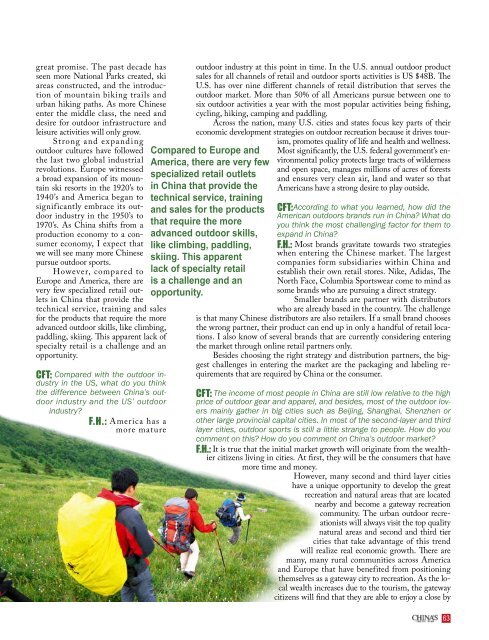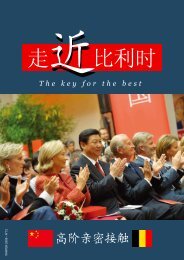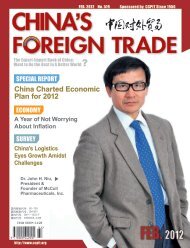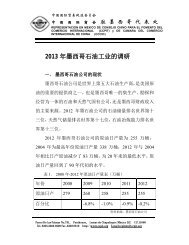Create successful ePaper yourself
Turn your PDF publications into a flip-book with our unique Google optimized e-Paper software.
great promise. The past decade has<br />
seen more National Parks created, ski<br />
areas constructed, and the introduction<br />
of mountain biking trails and<br />
urban hiking paths. As more Chinese<br />
enter the middle class, the need and<br />
desire for outdoor infrastructure and<br />
leisure activities will only grow.<br />
Strong and expanding<br />
outdoor cultures have followed<br />
the last two global industrial<br />
revolutions. Europe witnessed<br />
a broad expansion of its mountain<br />
ski resorts in the 1920’s to<br />
1940’s and America began to<br />
significantly embrace its outdoor<br />
industry in the 1950’s to<br />
1970’s. As China shifts from a<br />
production economy to a consumer<br />
economy, I expect that<br />
we will see many more Chinese<br />
pursue outdoor sports.<br />
However, compared to<br />
Europe and America, there are<br />
very few specialized retail outlets<br />
in China that provide the<br />
technical service, training and sales<br />
for the products that require the more<br />
advanced outdoor skills, like climbing,<br />
paddling, skiing. This apparent lack of<br />
specialty retail is a challenge and an<br />
opportunity.<br />
CFT: Compared with the outdoor industry<br />
in the US, what do you think<br />
the difference between China’s outdoor<br />
industry and the US’ outdoor<br />
industry?<br />
F.H.: America has a<br />
more mature<br />
Compared to Europe and<br />
America, there are very few<br />
specialized retail outlets<br />
in China that provide the<br />
technical service, training<br />
and sales for the products<br />
that require the more<br />
advanced outdoor skills,<br />
like climbing, paddling,<br />
skiing. This apparent<br />
lack of specialty retail<br />
is a challenge and an<br />
opportunity.<br />
outdoor industry at this point in time. In the U.S. annual outdoor product<br />
sales for all channels of retail and outdoor sports activities is US $48B. The<br />
U.S. has over nine different channels of retail distribution that serves the<br />
outdoor market. More than 50% of all Americans pursue between one to<br />
six outdoor activities a year with the most popular activities being fishing,<br />
cycling, hiking, camping and paddling.<br />
Across the nation, many U.S. cities and states focus key parts of their<br />
economic development strategies on outdoor recreation because it drives tourism,<br />
promotes quality of life and health and wellness.<br />
Most significantly, the U.S. federal government’s environmental<br />
policy protects large tracts of wilderness<br />
and open space, manages millions of acres of forests<br />
and ensures very clean air, land and water so that<br />
Americans have a strong desire to play outside.<br />
CFT:According to what you learned, how did the<br />
American outdoors brands run in China? What do<br />
you think the most challenging factor for them to<br />
expand in China?<br />
F.H.: Most brands gravitate towards two strategies<br />
when entering the Chinese market. The largest<br />
companies form subsidiaries within China and<br />
establish their own retail stores. Nike, Adidas, The<br />
North Face, Columbia Sportswear come to mind as<br />
some brands who are pursuing a direct strategy.<br />
Smaller brands are partner with distributors<br />
who are already based in the country. The challenge<br />
is that many Chinese distributors are also retailers. If a small brand chooses<br />
the wrong partner, their product can end up in only a handful of retail locations.<br />
I also know of several brands that are currently considering entering<br />
the market through online retail partners only.<br />
Besides choosing the right strategy and distribution partners, the biggest<br />
challenges in entering the market are the packaging and labeling requirements<br />
that are required by China or the consumer.<br />
CFT: The income of most people in China are still low relative to the high<br />
price of outdoor gear and apparel, and besides, most of the outdoor lovers<br />
mainly gather in big cities such as Beijing, Shanghai, Shenzhen or<br />
other large provincial capital cities. In most of the second-layer and third<br />
layer cities, outdoor sports is still a little strange to people. How do you<br />
comment on this? How do you comment on China’s outdoor market?<br />
F.H.: It is true that the initial market growth will originate from the wealthier<br />
citizens living in cities. At first, they will be the consumers that have<br />
more time and money.<br />
However, many second and third layer cities<br />
have a unique opportunity to develop the great<br />
recreation and natural areas that are located<br />
nearby and become a gateway recreation<br />
community. The urban outdoor recreationists<br />
will always visit the top quality<br />
natural areas and second and third tier<br />
cities that take advantage of this trend<br />
will realize real economic growth. There are<br />
many, many rural communities across America<br />
and Europe that have benefited from positioning<br />
themselves as a gateway city to recreation. As the local<br />
wealth increases due to the tourism, the gateway<br />
citizens will find that they are able to enjoy a close by<br />
63

















